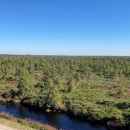About Us
Founded in 1991, the Columbia Fish and Wildlife Conservation Office has worked on dozens of projects throughout the midwest including measuring our invasive Asian carp catches in tons, surveying fish passage fish passage
Fish passage is the ability of fish or other aquatic species to move freely throughout their life to find food, reproduce, and complete their natural migration cycles. Millions of barriers to fish passage across the country are fragmenting habitat and leading to species declines. The U.S. Fish and Wildlife Service's National Fish Passage Program is working to reconnect watersheds to benefit both wildlife and people.
Learn more about fish passage locations in the thousands and transporting more pallid sturgeon broodstock broodstock
The reproductively mature adults in a population that breed (or spawn) and produce more individuals (offspring or progeny).
Learn more about broodstock to hatcheries than any other fish and wildlife conservation office in the region. Much has occurred during the last quarter century at the Columbia Fish and Wildlife Conservation Office, but our dedication to the people and natural resources of the United States remains the same.
Our Mission
The Columbia Fish and Wildlife Conservation Office has a diverse team prepared to assist with sportfish, native fish, imperiled species and invasive species invasive species
An invasive species is any plant or animal that has spread or been introduced into a new area where they are, or could, cause harm to the environment, economy, or human, animal, or plant health. Their unwelcome presence can destroy ecosystems and cost millions of dollars.
Learn more about invasive species assessment and management throughout the greater Mississippi River Basin. Whether it is diving for unionid mussels in Missouri Ozark streams, trawling for native fish in the Mississippi and Missouri Rivers, improving habitat and stream connectivity for imperiled species or developing novel sampling gears and modeling tools to meet new invasive species challenges, we are here to serve.
Our History
1991 - The Columbia Fisheries Resource Office was established with the hiring of the first project leader utilizing volunteers to conduct pond surveys on Department of Defense installations with an old 16ft jon boat.
1997-1999 - The office’s first river project was conducted with support of the Mississippi Interstate Cooperative Resource Association and the first pallid sturgeon was captured.
2001 - The Columbia Fisheries Resource Office team established a niche for developing novel capture gears for pallid sturgeon and small-bodied Missouri River Fishes.
2009 - The Columbia Fisheries Resource Office was renamed as the Columbia Fish and Wildlife Conservation Office.
2011 - Expanded novel gear development program to include invasive species invasive species
An invasive species is any plant or animal that has spread or been introduced into a new area where they are, or could, cause harm to the environment, economy, or human, animal, or plant health. Their unwelcome presence can destroy ecosystems and cost millions of dollars.
Learn more about invasive species where the prototype electrified trawls were conceived to improve Asian carp capture.
2018 - Magna Carpa, a refined electrified paupier, was deployed to support Asian carp removal efforts and consistently removed 7 tons of Asian carp per day in the Illinois River.
2019 - Traveling 65,000 miles per year, the Columbia Fish and Wildlife Conservation Office fully embraces the inter-jurisdictional fisheries role with projects in seven states supported by several U.S. Fish and Wildlife Service programs and other partner agencies.
Other Facilities in this Complex
We are co-located with the Missouri Ecological Services Field Office and Missouri Private Lands Office.
